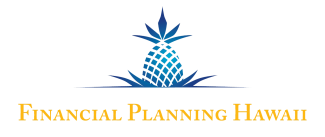
401(k) Loan vs. Home Equity Loan for Debt Consolidation
In some professional discussion forums, the notion that a financial planner might recommend a 401(k) loan is akin to heresy. However, recent restrictions on the tax treatment home equity loan interest and recent liberalization of rules pertaining to 401(k) loans leads me to challenge the prevailing orthodoxy in some client circumstances.
When to Use a HELOC
To begin, I routinely advise clients who are homeowners establish a home equity line of credit as a source of emergency reserves or as a source of funds for home renovations. In fact, the Robinsons just used a HELOC to finance a kitchen remodel and we are currently tapping it again to add a much needed She-Shed to the back yard (to be used exclusively by our Marketing Director and her mom).
In Hawaii, the credit limit on a standard HELOC is $250k. The standard terms are interest-only payments with a balloon payment after 10 years and no-prepayment penalty. Interest rates are typically variable, but I tend to favor HELOCs offering two or three-year rate locks.
Interest only accrues from the time you begin using the money and is only charged on the amount you have borrowed so far. These days, the standard variable rate for borrowers with strong credit seems to be around 5-7%, but one to three-year rate locks in the 2% to 4% range are usually attainable in Hawaii.
One FPH client recently obtained a 10-year rate lock at 3.75% for a local bank, which, in my opinion, is a great rate. I don’t know much about HELOC rates across the rest of the country, but offer the following article link as a starting point - The 8 Best HELOC Rates of 2019 (TheBalance.com).
Traditional HELOC Policies in Light of Recent Developments
Traditionally, HELOCs have made a great deal of sense for remodels and/or for consolidation of higher interest credit card or installment credit (e.g., auto loans). The general appeal has been that the HELOC interest rate is generally lower than unsecured loan options (e.g., credit card debt, personal loans) and the effective interest rate was made even lower by virtue of the deductibility of the loan interest on state and federal tax returns. However, the Tax Cuts and Jobs Act of 2018 eliminated the deduction of HELOC interest for purposes other than home improvement.
Even more significantly, the TCJIA eliminated a number of popular itemized deductions and capped the deductibility limit on state and local taxes at $10,000. As a result, far fewer taxpayers have enough deductions to exceed the standard deduction. No itemization = no interest deduction.
An Example from a Client...
To illustrate this by example, I met with a client last week who has a $200,000 balance on a HELOC that is fixed at 2.0 % for two more years. With the tax deduction, her effective interest rate would have been about 1.5 %, making it roughly a wash with the net, after-tax rate she could earn on a 1-year CD. In the absence of the deduction, however, I advised her to take the free cash in her bank accounts and her taxable investment account with me pay down the home equity line.
SIDEBAR: It is worth mentioning that she initially balked at the idea because she feels more comfortable having cash available for reserves. However, as I explained, if she needs more $, she can always write a check from her home equity line!
When to Use a 401(k) Loan
The rules for 401(k) loans are set by the IRS. The maximum amount one can borrow from a 401(k) is 50% of the account value of up to a maximum of $50,000. Repayment schedules are set by the plan administrator and payments are made through payroll deductions. The repayment term is 5 years for most distributions but may be as long as 15 years if used for a home purchase.
The IRS requires that interest be charged on the loan, however the interest is paid to the borrower’s own account. This represents a distinct advantage over other types of loans in which the interest payments are made to a financial institution. As long as the 401(k) plan permits participant loans, there are no credit score requirements and generally there are only nominal origination/processing fees.
The biggest knock on 401(k) loans is that funds borrowed are not available to grow for retirement. This is a legitimate point. However, if one uses only the conservative bond/cash portion of his/her 401(k) portfolio, there is likely to be little difference between the return from repaying the loan and the interest that would be earned if the loan was not taken.
HELOCs and 401(k)s
The fact that HELOC interest is no longer deductible for most people further narrows or eliminates a previous advantage of a HELOC over the 401(k).
The speed and ease with which one may process a 401(k) loan paired with the fact that the interest is repaid to the borrower’s own 401(k) account represent distinct advantages. The $50,000 maximum loan size is arguably the biggest disadvantage relative to the HELOC.
For consumers who carry credit card debt or installment loans (e.g. auto loans), a 401(k) loan may be an ideal refinancing option. Much like a HELOC it can also serve as a source of emergency reserves.
Related Reading:
7 Things to Know about 401(k) Loans Before You Take One (The Balance)
New 401(k) Rules Make Borrowing Slightly Less Risky (U.S. News)
4 Reasons to Borrow from your 401(k) (Investopedia)
Tax reform gives some 401(k) borrowers more time to repay (Credit Karma)
About the Author: John Robinson is the founder of Financial Planning Hawaii and a co-founder of software maker Nest Egg Guru. Dozens of papers he has written on a broad range of financial planning topics have been published in peer-reviewed academic journals and professional magazines. His commentary regularly appears in the national financial news media.
Disclosures: Securities offered through J.W. Cole Financial, Inc. (JWC) member FINRA/SIPC. Advisory services offered through Financial Planning Hawaii and J.W. Cole Advisors, Inc. (JWCA). Financial Planning Hawaii and JWC/JWCA are unaffiliated entities.
Fee-Only Financial planning services are provided through Financial Planning Hawaii, Inc, a separate Registered Investment Advisory firm. Financial Planning Hawaii does not take custody of client assets nor do its advisers take discretionary authority over client accounts.
The information contained herein is general in nature. Neither Financial Planning Hawaii nor J.W. Cole provides client specific tax or legal advice. All readers should consult with their tax and/or legal advisors for such guidance in advance of making investment or financial planning decisions with tax or legal implications.

